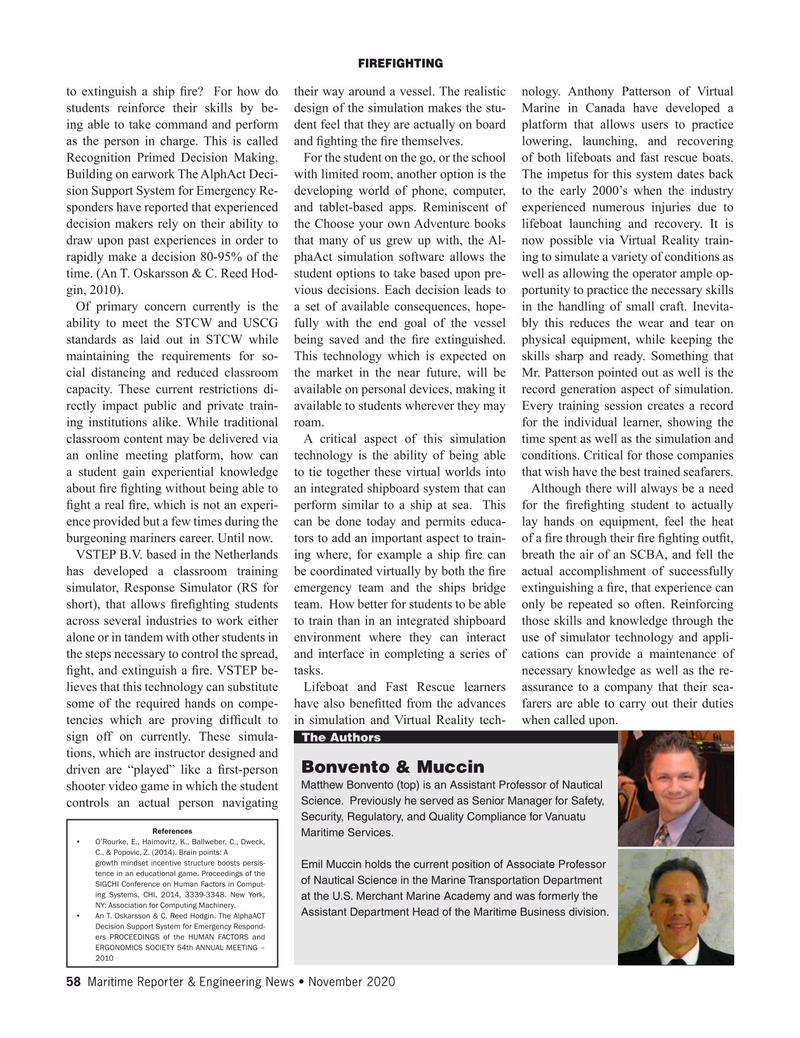
Page 58: of Maritime Reporter Magazine (November 2020)
Workboat Edition
Read this page in Pdf, Flash or Html5 edition of November 2020 Maritime Reporter Magazine
FIREFIGHTING to extinguish a ship ? re? For how do their way around a vessel. The realistic nology. Anthony Patterson of Virtual students reinforce their skills by be- design of the simulation makes the stu- Marine in Canada have developed a ing able to take command and perform dent feel that they are actually on board platform that allows users to practice as the person in charge. This is called and ? ghting the ? re themselves. lowering, launching, and recovering
Recognition Primed Decision Making. For the student on the go, or the school of both lifeboats and fast rescue boats.
Building on earwork The AlphAct Deci- with limited room, another option is the The impetus for this system dates back sion Support System for Emergency Re- developing world of phone, computer, to the early 2000’s when the industry sponders have reported that experienced and tablet-based apps. Reminiscent of experienced numerous injuries due to decision makers rely on their ability to the Choose your own Adventure books lifeboat launching and recovery. It is draw upon past experiences in order to that many of us grew up with, the Al- now possible via Virtual Reality train- rapidly make a decision 80-95% of the phaAct simulation software allows the ing to simulate a variety of conditions as time. (An T. Oskarsson & C. Reed Hod- student options to take based upon pre- well as allowing the operator ample op- gin, 2010). vious decisions. Each decision leads to portunity to practice the necessary skills
Of primary concern currently is the a set of available consequences, hope- in the handling of small craft. Inevita- ability to meet the STCW and USCG fully with the end goal of the vessel bly this reduces the wear and tear on standards as laid out in STCW while being saved and the ? re extinguished. physical equipment, while keeping the maintaining the requirements for so- This technology which is expected on skills sharp and ready. Something that cial distancing and reduced classroom the market in the near future, will be Mr. Patterson pointed out as well is the capacity. These current restrictions di- available on personal devices, making it record generation aspect of simulation. rectly impact public and private train- available to students wherever they may Every training session creates a record ing institutions alike. While traditional roam. for the individual learner, showing the classroom content may be delivered via A critical aspect of this simulation time spent as well as the simulation and an online meeting platform, how can technology is the ability of being able conditions. Critical for those companies a student gain experiential knowledge to tie together these virtual worlds into that wish have the best trained seafarers. about ? re ? ghting without being able to an integrated shipboard system that can Although there will always be a need ? ght a real ? re, which is not an experi- perform similar to a ship at sea. This for the ? re? ghting student to actually ence provided but a few times during the can be done today and permits educa- lay hands on equipment, feel the heat burgeoning mariners career. Until now. tors to add an important aspect to train- of a ? re through their ? re ? ghting out? t,
VSTEP B.V. based in the Netherlands ing where, for example a ship ? re can breath the air of an SCBA, and fell the has developed a classroom training be coordinated virtually by both the ? re actual accomplishment of successfully simulator, Response Simulator (RS for emergency team and the ships bridge extinguishing a ? re, that experience can short), that allows ? re? ghting students team. How better for students to be able only be repeated so often. Reinforcing across several industries to work either to train than in an integrated shipboard those skills and knowledge through the alone or in tandem with other students in environment where they can interact use of simulator technology and appli- the steps necessary to control the spread, and interface in completing a series of cations can provide a maintenance of ? ght, and extinguish a ? re. VSTEP be- tasks. necessary knowledge as well as the re- lieves that this technology can substitute Lifeboat and Fast Rescue learners assurance to a company that their sea- some of the required hands on compe- have also bene? tted from the advances farers are able to carry out their duties tencies which are proving dif? cult to in simulation and Virtual Reality tech- when called upon.
sign off on currently. These simula-
The Authors tions, which are instructor designed and
Bonvento & Muccin driven are “played” like a ? rst-person
Matthew Bonvento (top) is an Assistant Professor of Nautical shooter video game in which the student
Science. Previously he served as Senior Manager for Safety, controls an actual person navigating
Security, Regulatory, and Quality Compliance for Vanuatu
References
Maritime Services. • O’Rourke, E., Haimovitz, K., Ballweber, C., Dweck,
C., & Popovic, Z. (2014). Brain points: A growth mindset incentive structure boosts persis-
Emil Muccin holds the current position of Associate Professor tence in an educational game. Proceedings of the of Nautical Science in the Marine Transportation Department
SIGCHI Conference on Human Factors in Comput- ing Systems, CHI, 2014, 3339-3348. New York, at the U.S. Merchant Marine Academy and was formerly the
NY: Association for Computing Machinery.
Assistant Department Head of the Maritime Business division. • An T. Oskarsson & C. Reed Hodgin. The AlphaACT
Decision Support System for Emergency Respond- ers PROCEEDINGS of the HUMAN FACTORS and
ERGONOMICS SOCIETY 54th ANNUAL MEETING – 2010 58 Maritime Reporter & Engineering News • November 2020
MR #11 (50-65).indd 58 11/9/2020 11:42:07 AM

 57
57

 59
59
